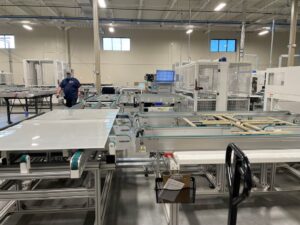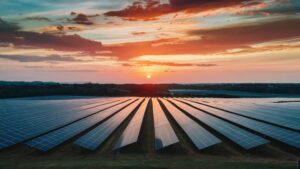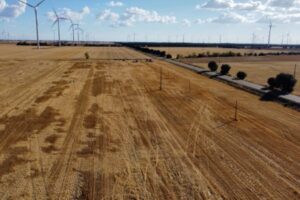Heliene navigates the pitfalls of modern manufacturing while helping farmers feed families


Heliene’s recently-expanded Mountain Iron, MN production line produces high-efficiency PV modules (courtesy: Heliene)
High-efficiency PV manufacturer Heliene prepares to open new Minnesota production lines
I flew through the new Terminal A at EWR in Newark earlier this month. I was pleasantly surprised by how efficient herding cattle (metaphorically, at least in this context) can feel when many human touchpoints are removed. I’m not sure that says anything particularly reassuring about people in general, but I didn’t have to take my laptop out of the bag… So that was nice.
Similar technological bells and whistles might be a few years away from cropping up in Duluth.
<DING>
A boarding announcement interrupts the start of my conversation with Martin Pochtaruk, president of Heliene. He’s in the Land of 10,000 Lakes for the week, scoping sites for new production lines in the Minneapolis-St. Paul metropolitan area. If you’ve never passed through the airport in Duluth, it’s exactly how you picture it.
Heliene (which is pronounced more like “hellion” than “hey, lean”) is a solar photovoltaic module manufacturer with facilities in Ontario, Canada, and Mountain Iron, Minnesota. The company sells ten variations of high-efficiency, high-quality solar photovoltaic modules.
“We are [higher-end], touching wood,” Pochtaruk laughs as he knocks his head.
Is that a selling point in a space saturated with cheaper imports?
“It has to be,” he replies. “Because otherwise, people don’t talk to you, right?”

Heliene constructed its U.S. facility in Mountain Iron, Minnesota in 2022, where the company is currently running two production lines to fulfill a massive 1.5 GW order for Nexamp. Heliene’s current capacity at that facility is 800 MW (300 MW on one line and 500 MW on another).
Over the next year, Pochtaruk intends to open two new production lines in Minnesota, one in Mountain Iron and another near the Twin Cities. He admits the IRA has made this expansion possible, but he’s more interested in leasing buildings this time around.
“Believe me, we will not do that again,” Heliene’s president laughs when asked about the facility pictured above. “We’re not in the business of building buildings. We’re building the business of making solar products, and that was a big distraction.”
Although Pochtaruk would love to get both new lines up and running in 2024, it’s likely one gets pushed to next year. Such a prudent approach, he contends, is evidence of how Heliene has survived 14+ years in North America while so many larger companies have failed.
“The only way that we’re able to compete face-to-face with imports is because we are cautious and we control our costs,” he explains. “With the level of dumping in the market and the high volume of imports, I’m sure you’ve heard that everybody is delaying a project. Everybody. Everybody! So are we!”
“Right now the market is awful,” he adds. “Everybody is complaining about it.”
Making stuff in the modern age
It’s not just the market (shakes fist in the direction of Wall Street) complicating the life of the modern manufacturer. Finding people eager and willing to work on assembly lines can be enough of a challenge that Heliene has purposefully selected locations for its production facilities near a pool of potential employees who are “used to working for a living,” like mining areas.
Pochtaruk sees the temperament of the modern worker as a challenge facing not just renewables, but All Industries Who Make Stuff.
“It didn’t used to be this way,” Heliene’s president laments. “It’s not as easy to recruit as it used to be.”
“We need people that show up for 12-hour shifts on time. Crews are 22-23 people and you need all [of them] to show up, not half,” he adds.
Pochtaruk started his career with pride in 1990 when assembly line gigs were a little more en vogue and cargo pants were as cool as they are now.
“Manufacturing isn’t fashionable anymore,” he argues. “Particularly because for most jobs in manufacturing, you need to be at the manufacturing line. You cannot do it from home.”
Pochtaruk personally understands the dilemma. He has kids of his own, 25 and 29. Both work from home.
“My son is actually based in Korea, but he can work from wherever on the planet he feels like. So it’s in Argentina right now,” Pochtaruk chuckles. “He could basically be on a beach, right? That is the aspiration of many.”
“They want to have that freedom, but manufacturing ties you down. It’s a product of the times we live.”
– Heliene President Martin Pochtaruk on the dilemma facing modern manufacturing
“How do you solve it?” he asks rhetorically. “You offer more money.”
Pochtaruk says Heleine paid between $17.50 and $20 per hour pre-pandemic.
“Now it’s $21 and the benefits are much better,” he concedes. “And they’re for the entire family, not just for the employee because otherwise, you don’t hire anyone.”
If you think millennials care about their families, wait til you get one of them started on their dog! But Heliene has got that angle covered, too.

Laugh if you like, but posting an inclusive memo purportedly penned by a cute dog ahead of all the human employee bios on the company’s “About Us” page speaks volumes to Heliene’s awareness of what kids these days are looking for in an employer.
Heliene onboards its recruits five to eight weeks before a new line launches and trains them on a nearly identical parallel line. This allows the fresh hires to get a feel for the sorting machines, laminators, and other equipment. Well, not a literal feel.
“These manufacturing lines are highly automated. There’s no human touch,” says Pochtaruk.
One can only hope it runs as smoothly as the new EWR terminal.
Helping farmers feed families through agrivoltaic innovation
The moniker Heliene is a portmanteau of “Helios,” the Green sun god, and the word “energy.” Finding prospects to generate power from that big glowing ball in the sky is literally a part of the company’s name.
Martin Pochtaruk and his team saw such an opportunity in the greenhouse sector in Ontario, Canada, where 170 growers farm a lot of produce that gets exported to the United States. Power has been classically cheap there.
“But because of that, the greenhouse sector has grown so much that there just isn’t enough power,” explains Patrick Gossage of Heliene’s special projects and product innovation team. “Yet there’s large opposition to building solar plants on that farmland because they don’t want to take premium farmland out of production. Farmers feed cities- that whole argument.”
We’re having similar discussions stateside. Developers are squeezing BESS projects into densely populated city centers while resistance to renewable projects percolates in the heartland. Can farmers help power America, too?
Gossage and his team identified a workaround. You can’t build on the farm fields, but you can put solar panels on rooftops… So why not greenhouses too?

It would take some refined tech to make it work. Heliene developed a frameless, semi-transparent solar module to replace some panels of greenhouse glass. Each is covered in a special nanocoating that shifts frequencies of light toward the orange and red end of the spectrum to accelerate photosynthesis.
Heliene tested the concept at scale with a 600-module, 66 KW peak solar installation that powered 10% of the greenhouse’s needs. Niagra College came on board to assist with an independent yield analysis for the crops under the solar modules. “If I’m fully honest, I wasn’t sure it was gonna work,” laughed Gossage.
Niagra found the potted basil plants under those special solar modules grew just as well, if not better.
“This was my Eureka moment,” exclaimed Gossage. “Oh, my God, this can actually work! You can have this dual-use.”
Since then, Gossage has founded an organization called Agrivoltaics Canada, a nonprofit that informs Canadian policymakers of the benefits of dual land use. He has developed close ties with folks at NREL and Dan French, who started the Solar Farm Summit in the United States.
“There’s a real community in the agrivoltaics sector that’s being built,” he offers.
Although many best practices were pioneered by our progressive, land-short friends in Europe, Gossage believes interest from the United States will finally help move the dual-use sector forward. “The U.S. has supercharged this idea and you know it’s bigger and better as a result,” he says.
“Canada, quite frankly, needs to play catch up and look at the bipartisan infrastructure bills that are being passed in the United States. If you can get bipartisan bills passed in the U.S., you should be able to get bills passed in any government anywhere.”
The intersection of agriculture and power generation
Heliene’s next iteration of the greenhouse-integrated PV module will incorporate quantum dots that convert UV light into photosynthetically active radiation in the 400 to 750 nanometer wavelength. It will come in two configurations with different levels of light transmissibility- one with 33% cell coverage, the other with 66%.
“In layman’s terms, we’re using light that is not usable by any plants and enhancing the amount of light that is photosynthetically active to offset any light attenuation,” Heliene’s Gossage explains.
“There’s a long-held saying from farmers that any micromole reduction in light equates to an equivalent percentage reduction in growth,” he pontificates. “And we don’t think that’s actually true. We think that varies dramatically across different crop types and geographies.”
Heliene plans to put that hypothesis to the test by participating in two more agrivoltaics pilots that it calls “the intersection between agriculture and power generation,” partnering with Connexus in Minnesota and National Research Energy Laboratories in Colorado.
“We’re doing some testing on two different geographies with quite different climatic conditions and doing field agrivoltaics at utility scale,” beams Gossage. He says one of the projects is three years long and begins in June.
“Stay tuned on that one,” he smiles.
<DING>
Another boarding announcement cuts through the din of the Duluth airport. Martin Pochtaruk has got places to be and people to see, but he’s always got time to talk about trying something new. He’s all-in on Heliene’s agrivoltaics efforts.
“99.9% of our revenue comes from making modules for projects,” Heliene’s president theorizes. “But we dedicate time and effort to this type of thing because, basically, without innovation we don’t have a future product, right?”
“We have to dedicate that time so that the .01% actually grows into being niche products that secure revenue going forward.”




